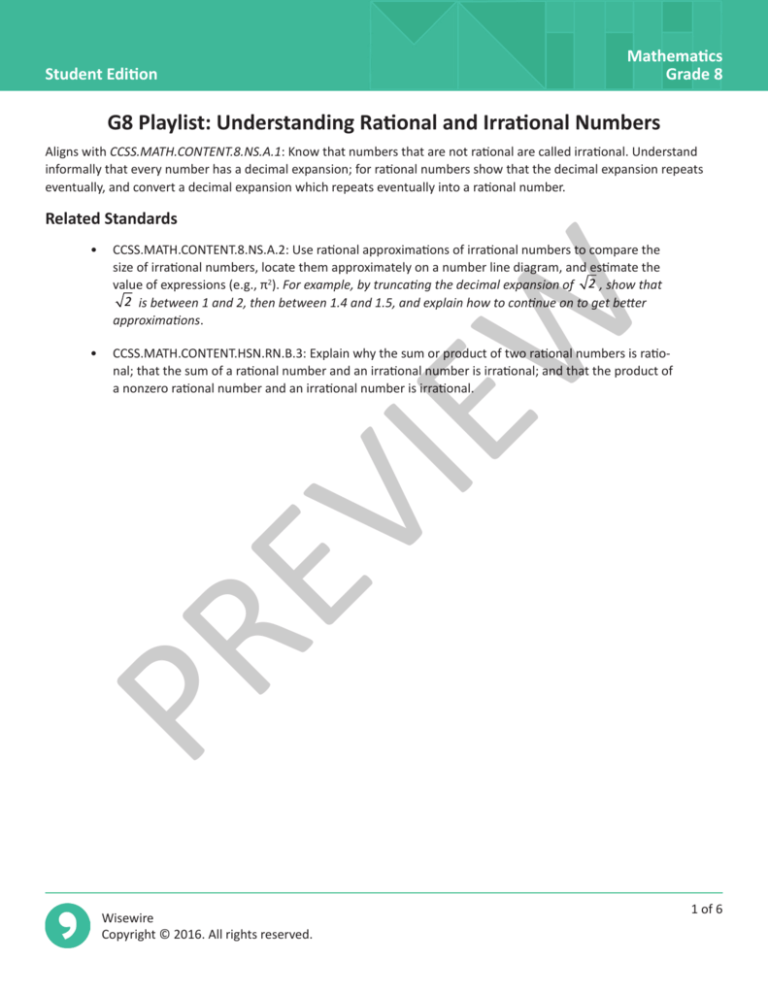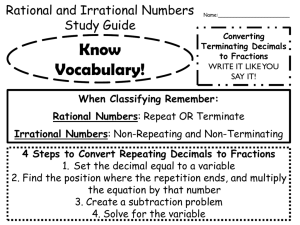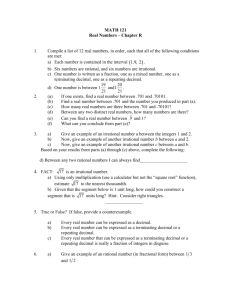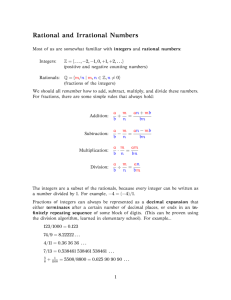
Mathematics
Grade 8
Student Edition
G8 Playlist: Understanding Rational and Irrational Numbers
Aligns with CCSS.MATH.CONTENT.8.NS.A.1: Know that numbers that are not rational are called irrational. Understand
informally that every number has a decimal expansion; for rational numbers show that the decimal expansion repeats
eventually, and convert a decimal expansion which repeats eventually into a rational number.
Related Standards
EW
• CCSS.MATH.CONTENT.8.NS.A.2: Use rational approximations of irrational numbers to compare the
size of irrational numbers, locate them approximately on a number line diagram, and estimate the
value of expressions (e.g., π2). For example, by truncating the decimal expansion of 2 , show that
2 is between 1 and 2, then between 1.4 and 1.5, and explain how to continue on to get better
­approximations.
PR
E
VI
• CCSS.MATH.CONTENT.HSN.RN.B.3: Explain why the sum or product of two rational numbers is rational; that the sum of a rational number and an irrational number is irrational; and that the product of
a nonzero rational number and an irrational number is irrational.
Wisewire
Copyright © 2016. All rights reserved.
1 of 6
Mathematics
Grade 8
Student Edition
Objectives
In this module, you will learn and practice the following skills:
• Understand the difference between rational and irrational numbers.
• Classify numbers as rational or irrational.
• Write repeating decimals as fractions.
Key Terms
EW
Let’s get started!
a
• A rational number is any number that can be written as the ratio of two integers, , where b is not 0.
b
• A terminating decimal is a decimal with a finite number of digits.
• A repeating decimal is a decimal in which a digit or group of digits repeats in a pattern.
• An irrational number is a number that cannot be written as the ratio of two integers.
PR
E
VI
• A perfect square is a whole number whose square root is an integer.
Wisewire
Copyright © 2016. All rights reserved.
2 of 6
Mathematics
Grade 8
Teacher Edition
Understanding Rational and Irrational Numbers
(8.NS.A.1)
•
Integers
•
Fractions
•
Mixed numbers
•
Terminating decimals
•
Repeating decimals
EW
a
A rational number is any number that can be written as the ratio of two integers, , where b is not 0. Rational numbers
b
include:
To write a terminating decimal as a fraction, use the place value of the last digit in the decimal as the denominator of the
fraction. Simplify if possible.
2694 1,347
=
10,000 5,000
To write a repeating decimal as a fraction, write and solve an equation. Let x be the repeating decimal. Multiply x by the
power of 10 given by the number of repeating digits.
0.2694 =
VI
0.83 as a fraction.
Write Let x = 0.83.
There are 2 repeating digits, so multiply by 102 = 100.
PR
E
100 x = 83.83
Define the variable.
100 x − 0.83 = 83.83 − 0.83
Subtract 0.83 from both sides.
100 x − 0.83 = 83
100 x − x = 83
Since x = 0.83 , substitute 0.83 for x.
99 x = 83
Simplify.
x=
Divide
83
99
Therefore, 0.83 =
83
99
Wisewire
Copyright © 2016. All rights reserved.
1 of 2









